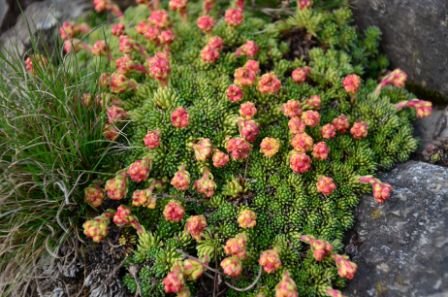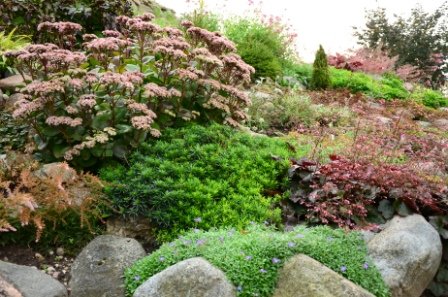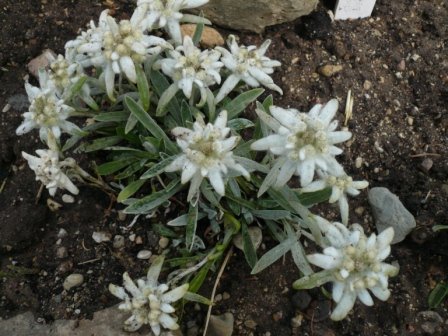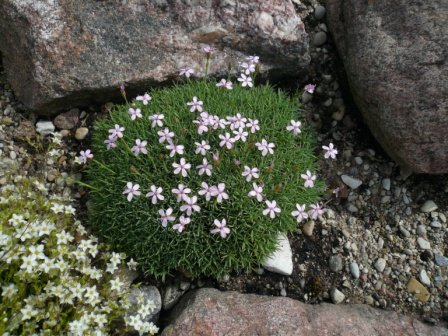The purpose of the division is to gather a collection of mountain flora, suitable for cognitive and educational purposes, carrying out plant evaluation and scientific research.
The division includes 1145 woody and herbaceous plants with 964 species and 181 breeds belonging to 70 families. The collection is grown in a small rock-garden and is divided into several sections of different areas, where plants from Europe, Asia, American Cordillera and the Far East Region are cultivated. The most prevalent families of the collection are: aster (Asteraceae) with 106 species and breeds, stonecrop (Crassulaceae) (105 species), buttercup (Ranunculaceae) (95 species), cabbage (Brassicaceae) (62 species), bellflower (Campanulaceae) (50 species) and carnation (Caryophyllaceae) (71 species). The genera with the largest species include: breakstone (Saxifraga), gentian (Gentiana), bellflower (Campanula), stonecrop (Sedum) and primrose (Primula).

The majority of plants in the collection are grown from seeds brought from various botanical gardens around the world through seed exchange programme. Šiauliai University Botanical Garden collaborates with other botanical gardens with alpine plant collections from Austria, Italy, France, Switzerland, Germany, Czech Republic, Canada, Norway, Sweden and Russia. Most of world’s alpine botanical gardens located in mountain regions also add seeds, which are collected from wildlife habitats, to their seed catalogue. For the purpose of building a rich alpine plant collection we focus on obtaining seeds gathered from their natural habitats. The largest part of our collection contain European mountain flora. The plants are selected regarding their origin, ornamental traits, species abundance and useful properties. We also greatly appreciate plant collectors’ collaboration and contribution to our garden.The origin of division’s plants

The alpine plants of the division are grown in a rock-garden and hotbeds. The rock-garden is built on an artificial hill and covers 7.5 ares. Herbaceous mountain flora is influenced by changing climate conditions of vertical zonality as well as harsh growing conditions and, therefore, contains a large morphological variety with numerous tufted, evergreen, dwarf, rosette, thick-leaved, fluffy and leathery-leaved plants. Due to physical and geographical barriers, limiting the plant population, there are plenty of rare endemic species growing in the mountains. Consequently, specific ecological conditions, similar to the ones taking place in mountain regions, must be provided in order to successfully grow the majority of alpine species. Some species require chalky soil while others prefer more acidic environment. The humidity and lighting requirements differ as well. Some of the collection’s plants, including alpine species, are grown in hotbeds as they cannot survive the outdoor growing conditions in the garden.Growing conditions
Fascinating plants
Owing to their huge variety alpine plants are largely popular worldwide. There are many plant growers associations established in various countries uniting world’s numerous alpine plant growers and fans. Our division also contains a large collection of phenomenal species with their interesting ornamental properties and other unique traits, some of which are even mentioned in legends. Some of these species include:

Lion’s-foot (Leontopodium alpinum), also known as edelweiss, grows in European mountains, 1800–3000 m altitude, prefers chalky soil. Lion’s-foot is popular for its silver flowers and unusual appearance. The whole plant along with its flowers is covered in soft dense hair, which adds a greyish tone to the plant’s colour. Lion’s-foot is also widely known as a symbol of alpinism and as a national flower in some countries. According to legends, young men used to climb the mountains and look for edelweiss that they could present to their women as a proof of eternal love.
Yellow gentian (Gentiana lutea), commonly known as bitter root, gets its name from Illyrian king Gentius, who lived 500 BC and was the first one to treat people using gentian plant during the plague. The tallest gentians are prevalent in central and southern parts of Europe, where the flowering stems can occasionally grow up to 2 meters in height. It is believed that yellow gentian was the first gentian species to be grown in gardens. The rhizomes and roots of gentian plant contain tonic bitterness and are used as material for medicine.
Relic plants, belonging to ephedra genus, are conifer ancestors that have survived the ice age and are prevalent to this day. Ephedra minima (Ephedra monosperma) is one of the most beautiful species of ephedra genus. It is commonly found in areas of China and Siberia and prefers rocky slopes and dry places. This small, dense and robust shrub grows 20 cm in height and contains green stems with knotted nodes that resemble horsetail plants. Ephedra minima’s leaves possess some unusual traits. They are tiny, scaly and unable to perform photosynthesis. The plant contains bright red, succulent fruits, 6–9 mm in diameter, each holding only one seed. The seed is surrounded by a fleshy cone that becomes orange or red during maturity and has a resemblance to a berry. Ephedra is one of the world’s oldest known medicinal plants, although it is currently banned in many countries due to the reports of its serious side effects. Ephedrine extract is used in the Traditional Chinese and Japanese Medicine. A tea, made from dried ephedra seeds mixed with white tea or herbs, is made in Mongolia.
Azorella (Azorella trifurcata), commonly found in South America (Chile, Argentina), is one of the most effective carpeting plants. It grows up to 10 cm in height and forms a rigid green tufted “carpet”. Azorella has small yellow flowers, which bloom during the months of June and July. The plant prefers direct sunlight and spreads vegetatively to retain heat. Azorella is grown in light, sandy soil, contains edible roots.Long-leaved whorl flower (Morina longifolia) is naturally found in Himalayan Mountains, 3000–4000 m altitude. The Latin name “morina” was given in honour of a French botanist Louis Morin. Long-leaved whorl flower has been grown in gardens since 1839. The flowers of the plant are exceptionally ornamental. Small white blossoms form gorgeous inflorescences that grow out of plant’s whorl. After the pollination the blossoms start getting a red shade and eventually become completely red. Plant’s stem, leaves and flowers were used in Tibet medicine for their sweetish taste and digestion-enhancing properties. Upon touching or rubbing, the leaves and flowers give out a pleasant citrus smell. The scent of flowers particularly intensifies at night. Long-leaved whorl’s roots contain essential oil, which is used for incense production. It is believed that the scent of long-leaved whorl flower repels garden pests.
Alpine pink (Dianthus erinaceus ssp. alpinus) is common in Anatolian peninsula and Turkish mountains. The plant expands forming a typical ornate, cushion-like shape. It contains narrow, lanceolate greyish evergreen leaves. Alpine pink grows short, only 10–15 cm in height, however it spreads widely, filling up large areas. Its flowers are not abundant, blooming with several small pink blossoms between leaves. Alpine pink is an ideal plant for warm sunny areas and dry rock-gardens. Alpine pink plants tend to grow slowly, are durable and dislike excess moisture.

Alpine plants become active in early spring and some plants start blooming at the end of March, when the garden is less frequently visited. However, the peak bloom does not start until June–July. Although the flowering decreases during the middle of the summer, there are still various beautiful dense cushion plants in the rock-garden to gaze upon. The plants' shapes and foliage variety are as beautiful as their flowers. As the majority of division's plants are evergreen the rock-garden can also be visited in autumn for a fascinating view of plants with diverse colours.The blooming season
Short history
The idea to create an alpine garden was proposed 17 years ago by a former director of Šiauliai Botanical Garden prof. Vida Motiekaitytė. In the year 2000 a rock-garden was started on an artificial hill, first stones were laid and, a year later, first seedlings were planted. In 2001 the establishment of alpine plants' collection was entrusted to a botanist Rimanta Vainorienė—a new employee at that time.
Division supporters
Private individuals have supported the development of rock-garden over the years by donating various materials: stones, dolomite, peat, sand. Valuable plants are annually donated by our friends—Latvian flower farm “Bērziņi“. Šiauliai Botanical Garden is collaborating with collectors, horticulturists: Genovaitė Pociūlienė, Rasa Miceikienė, Meilutė Mociškytė, Algirdas Gražys and a volunteer photographer Romualdas Struoga.
The division is administrated by a PhD Rimanta Vainorienė, e-mail:
